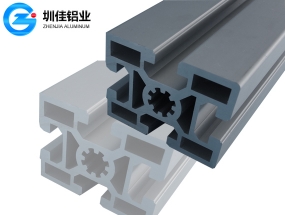The deformation of the metal in the barrel is extremely uneven, and there are two hard-to-deform areas: a corner at the junction of the barrel and the mold, called the front-end deformation area, usually called the dead area, and one in contact with the gasket. The back end, called the back end difficult deformation area.
 In the basic extrusion stage, the aluminum profile located in the dead zone does not undergo plastic deformation and does not participate in the flow. The reason for the dead zone is that the energy consumed by the metal sliding along the adc plane is smaller than that along the abc plane and the ac plane. At the same time, the metal here is cooled by the extrusion cylinder and the mold, and the plasticity is low, and the strength is high and it is not easy to flow.
In the basic extrusion stage, the aluminum profile located in the dead zone does not undergo plastic deformation and does not participate in the flow. The reason for the dead zone is that the energy consumed by the metal sliding along the adc plane is smaller than that along the abc plane and the ac plane. At the same time, the metal here is cooled by the extrusion cylinder and the mold, and the plasticity is low, and the strength is high and it is not easy to flow.
The factors affecting the size of the dead zone include the mold angle α, the position of the die hole, the extrusion ratio, the friction force, and the strength characteristics and uniformity of the metal. Increasing the frictional force of the mold angle α will promote the dead zone to increase, so the dead zone of the flat mode is larger than the conical mode, the extrusion ratio increases, αmax increases, and the dead zone volume decreases. As can be seen from the graph, the α angle changes little when the extrusion ratio increases to more than 13-17. Experiments show that improving the lubrication conditions can change the α angle and reduce the dead zone. Under good lubrication conditions, even with flat-die extrusion, the dead zone may even disappear when the extrusion ratio increases to a certain extent. The hot extrusion is close to the corner of the mold where the metal is easily cooled by the tool, so that the deformation resistance increases, it is difficult to flow, generally larger than the cold extrusion of the dead zone. The influence of the die hole position on the dead zone is obvious. The closer the die hole is to the die barrel wall, the smaller the dead zone is.
During the extrusion process, due to changes in the above factors, the size and shape of the dead zone must be changed. Usually with the progress of the extrusion process, the dead zone often increases.
The existence of a dead zone has both advantages and disadvantages. The dead zone hinders defects and impurities on the surface of the ingot from flowing to the surface of the product and improves the quality of the aluminum product. Therefore, in practice, flat die production with large dead zones is generally used. However, if the plasticity of the metal is reduced during extrusion and the plasticity is reduced, and the extrusion speed is high or the metal is strongly oxidized before extrusion, and when the lubrication barrel is used, breakage may occur at the boundary between the dead zone and the plastic flow zone. Cracks, dead skin, and mold wear increase.
For hard-to-deform areas at the back end, when the friction between the barrel and the ingot is large, the metal will flow toward the center, but the metal in the area 7 is cooled by the gasket and is hindered by the friction on the gasket. It is difficult to flow, causing the metal in the vicinity of zone 7 to be compressed in the middle, forming a narrow neck zone 6. In the extrusion, the shape and size of the hard-to-deform region at the rear end are constantly changing, and the volume of the hard-to-deform region 7 becomes 7? wedge-shaped at the end of the basic extrusion stage.


 In the basic extrusion stage, the aluminum profile located in the dead zone does not undergo plastic deformation and does not participate in the flow. The reason for the dead zone is that the energy consumed by the metal sliding along the adc plane is smaller than that along the abc plane and the ac plane. At the same time, the metal here is cooled by the extrusion cylinder and the mold, and the plasticity is low, and the strength is high and it is not easy to flow.
In the basic extrusion stage, the aluminum profile located in the dead zone does not undergo plastic deformation and does not participate in the flow. The reason for the dead zone is that the energy consumed by the metal sliding along the adc plane is smaller than that along the abc plane and the ac plane. At the same time, the metal here is cooled by the extrusion cylinder and the mold, and the plasticity is low, and the strength is high and it is not easy to flow.